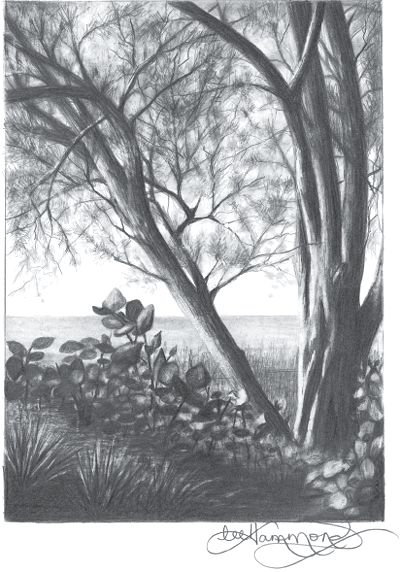
Now that we have drawn trees in silhouette form, it is time to move on to a tree in detail. A silhouette shows a tree’s basic shape, but a close-up shows the detail and texture. This exercise will give you an idea of how to create lifelike texture in tree bark.
.5mm mechanical pencil with 2B lead
kneaded eraser
ruler
smooth bristol paper
tortillion
Look for photo references that have good lighting. Having strong contrasts of tone helps give the drawing more intensity.

Draw the shapes of the tree lightly. The crook of the tree is a V-shape. With a small amount of shading, apply the tones to the left of the tree and on the tree using your pencil. The form being created resembles a cylinder. Keep the form of a cylinder in mind as you work.

Add more tone with your pencil to the tree and the background. Blend it out with a tortillion until it looks smooth. Deepen the dark details around the knothole and in the bark using firm pencil strokes. Notice how the reflected light along the edges of the trunk and branches helps the tree look rounded and cylindrical.

Deepen the tones in the background and blend again.
With firm pencil strokes, continue adding the look of texture to the tree bark. Add some curved strokes on the right limb to make its roundness more obvious. This gives it the illusion of being a birch tree.
Lift highlight areas out with a kneaded eraser. This makes the tree look more dimensional. The light area on the left limb gives the illusion of being lit by sunshine.
(Just for fun, I added the monarch butterfly. While it may look complicated, it is easy if you look at it as a puzzle of connecting shapes. Little things like this can make even a small drawing look impressive.)

MY FAVORITE SPOT AT THE BEACH
Graphite on smooth bristol
8” × 6” (20cm × 15cm)
This drawing is an example of applying everything we have learned so far. The composition has a clear horizon line just below the center, creating the look of distance.
The drawing has a good sense of a light source coming from the back left. This illuminates the trees along the left side. The extreme contrasts of light and dark give the tree trunks and limbs an obvious cylindrical look.
The shading used in the foliage of the trees causes it to look somewhat out of focus and makes everything else look more distinct.